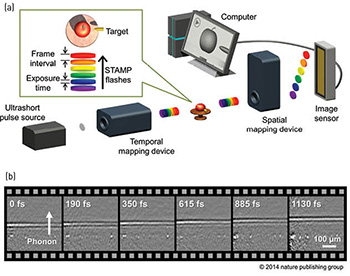 (a) Sequentially timed all-optical mapping photography (STAMP). An ultrashort laser pulse is split by the temporal mapping device into discrete daughter pulses in different spectral bands, which are incident on the target as successive flashes for stroboscopic image acquisition. The image-encoded daughter pulses are optically separated by the spatial mapping device and directed toward different areas of the image sensor. Data recorded by the image sensor are digitally processed to reconstruct a motion picture. (b) STAMP movie of phonon-polariton pulse propagation with an average frame interval of 229 fs (frame rate of 4.4 trillion frames per second). STAMP’s frame rate enables observation of the THz phonon pulse that propagates as fast as one sixth of the speed of light.
(a) Sequentially timed all-optical mapping photography (STAMP). An ultrashort laser pulse is split by the temporal mapping device into discrete daughter pulses in different spectral bands, which are incident on the target as successive flashes for stroboscopic image acquisition. The image-encoded daughter pulses are optically separated by the spatial mapping device and directed toward different areas of the image sensor. Data recorded by the image sensor are digitally processed to reconstruct a motion picture. (b) STAMP movie of phonon-polariton pulse propagation with an average frame interval of 229 fs (frame rate of 4.4 trillion frames per second). STAMP’s frame rate enables observation of the THz phonon pulse that propagates as fast as one sixth of the speed of light.
High-speed photography opens doors to new scientific discoveries by uncovering dynamics hidden within short time windows.1 However, the speed of conventional high-speed cameras is limited by the processing power of mechanical and electrical components. Time-resolved imaging based on the pump-probe method requires that events of interest be reproducible for repetitive measurements.2,3 Therefore, the conventional methods cannot be used to capture complex, non-repetitive, dynamic events on time scales of less than 1 ns.
This year we reported a new method for motion picture photography that obtains continuous, single-shot, burst-type images without the need for repetitive measurements.4 This method, sequentially timed all-optical mapping photography (STAMP), allows for movie shooting at over four trillion frames per second—a record in burst imaging. The principle of STAMP is all-optical mapping of the target’s time-varying spatial profile onto a burst stream of sequentially timed photographs by using spatial and temporal dispersion. Its key feature is its ability to spatially separate successive 2-D photographs in the optical domain while satisfying the condition for image formation on the image sensor. STAMP’s all-optical frame separation without active mechanical and electronic components circumvents the speed bottleneck in the conventional burst cameras, allowing for multi-dimensional “motion picture femtophotography” at an unprecedented speed of 100 fs per frame.
STAMP has been used for real-time visualization of ultrafast dynamic events such as laser ablation and lattice vibrational waves (phonons). The figure shows a STAMP movie of the propagation of coherent THz phonon-polariton waves in a ferroelectric crystal wafer (LiNbO3) produced by impulsive stimulated Raman scattering with a cylindrically shaped femtosecond laser pulse. Other than this example, STAMP holds great promise in terms of practical utility for studying and optimizing a diverse range of complex dynamical processes in photochemistry, plasma physics, condensed matter physics, semiconductor physics, ultrasound therapy and micro- and nano-fluidics.
Researchers
Keiichi Nakagawa, Ichiro Sakuma and Keisuke Goda, University of Tokyo, Japan
Fumihiko Kannari, Keio University, Japan
References
1. S.F. Ray. High Speed Photography and Photonics, SPIE Press (2002).
2. P. Hockett et al. Nature Phys. 7, 612 (2011).
3. A. Velten et al. Nat. Commun. 3, 745 (2012).
4. K. Nakagawa et al. Nature Photon. 8, 695 (2014).
